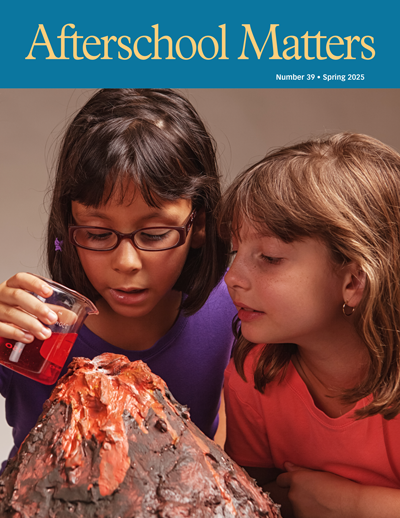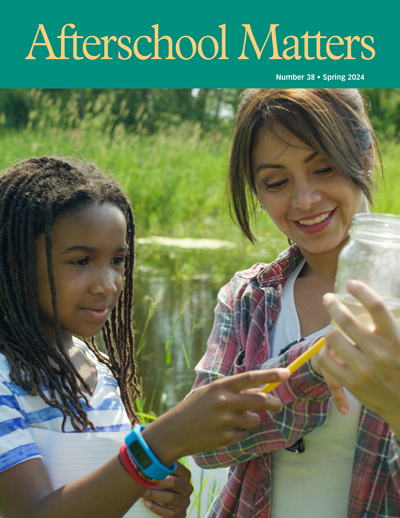A New Way to Assess Nutrition Knowledge: The Healthy Plate Photo Method
By Ashley Walther, Weiwen Chai, Tara Dunker, Lisa Franzen-Castle, and Michelle Krehbiel
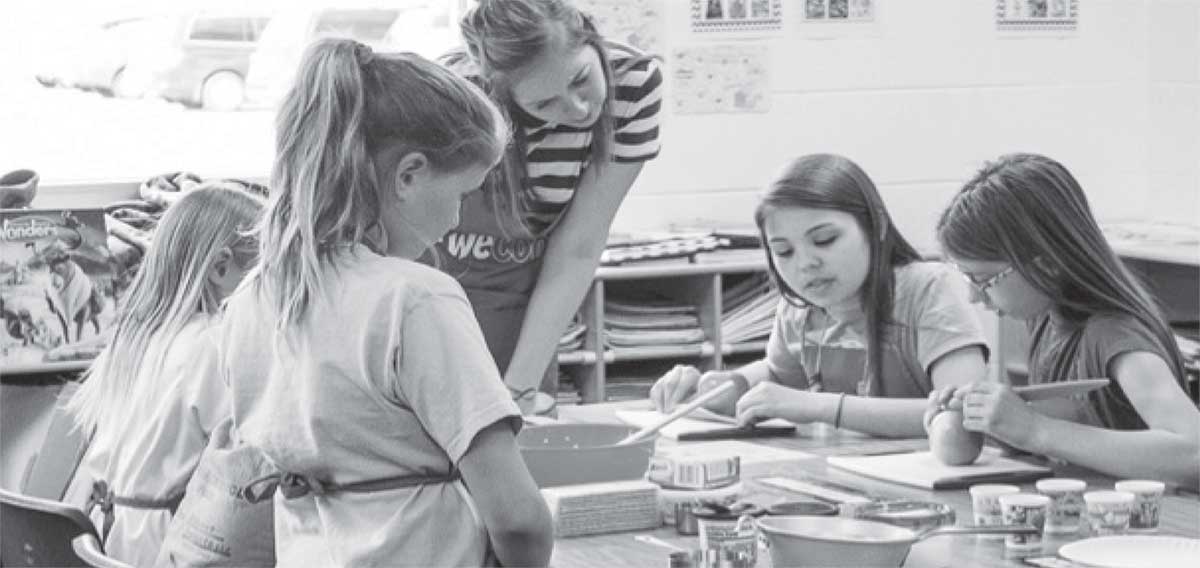 Out-of-school time (OST) programs serve youth from diverse demographic backgrounds. According to the Afterschool Alliance, of the 10.2 million young people in OST programs in the U.S., 24 percent are African American and 29 percent are Latinx; 45 percent qualify for free or reduced-price school meals (Afterschool Alliance, 2014). Research has shown that youth from low-income and minority backgrounds consume less healthy diets than youth from high-income families (Kant & Graubard, 2006). OST programs, whose informal settings provide opportunities for experiential learning, can address this problem by implementing nutrition and food-preparation programming to improve participants’ dietary knowledge and behaviors. Our contribution to this effort is WeCook: Fun with Food and Fitness, an OST curriculum for fourthand fifth-grade students focusing on food preparation, nutrition, and physical activity. In the process of piloting this program, we discovered the need for a nutrition assessment that would be time-efficient, developmentally appropriate, and user-friendly. Our solution was to develop a novel tool called the Healthy Plate Photo (HPP) method, based on the U.S. Department of Agriculture (USDA) MyPlate guidelines (USDA, 2017).
Out-of-school time (OST) programs serve youth from diverse demographic backgrounds. According to the Afterschool Alliance, of the 10.2 million young people in OST programs in the U.S., 24 percent are African American and 29 percent are Latinx; 45 percent qualify for free or reduced-price school meals (Afterschool Alliance, 2014). Research has shown that youth from low-income and minority backgrounds consume less healthy diets than youth from high-income families (Kant & Graubard, 2006). OST programs, whose informal settings provide opportunities for experiential learning, can address this problem by implementing nutrition and food-preparation programming to improve participants’ dietary knowledge and behaviors. Our contribution to this effort is WeCook: Fun with Food and Fitness, an OST curriculum for fourthand fifth-grade students focusing on food preparation, nutrition, and physical activity. In the process of piloting this program, we discovered the need for a nutrition assessment that would be time-efficient, developmentally appropriate, and user-friendly. Our solution was to develop a novel tool called the Healthy Plate Photo (HPP) method, based on the U.S. Department of Agriculture (USDA) MyPlate guidelines (USDA, 2017).
ASHLEY WALTHER, MS, was, at the time of this research, a graduate student in the Department of Nutrition and Health Sciences at the University of Nebraska-Lincoln (UNL). WEIWEN CHAI, PhD, is assistant professor in the Department of Nutrition and Health Sciences at UNL. TARA DUNKER, MS, is a registered dietician and state project coordinator for WeCook at UNL Extension. LISA FRANZEN-CASTLE, PhD, a registered dietician, is associate professor and extension nutrition specialist in the Department of Nutrition and Health Sciences at UNL. MICHELLE KREHBIEL, PhD, is associate professor and extension youth development specialist at UNL Extension.
We used this tool, in conjunction with a conventional paper survey, to assess nutrition knowledge before and after children participated in WeCook.
HPP’s innovative approach is appropriate in OST settings because it is hands-on and fun for students; it is also easy for staff to conduct. To demonstrate their nutrition knowledge, children build a healthy plate (as defined by USDA) using plastic food models. The results of our pilot study suggest that the HPP method can be a practical and useful nutrition assessment tool for OST programs to use with youth from varied socioeconomic and racial/ethnic backgrounds.
Traditional Nutrition Assessments
Self-reported paper surveys traditionally have been used to assess nutrition and healthy behavior knowledge, behavior, and self-efficacy in young participants (Burrows, Lucas, Morgan, Bray, & Collins, 2015; Cunningham-Sabo & Lohse, 2013; Davis, Ventura, Cook, Gyllenhammer, & Gatto, 2011). As a quantitative form of data collection, paper surveys provide convenience, reliability, and validity. However, researchers face challenges when using paper surveys with many youth populations. One challenge in using paper surveys is test anxiety. Since the implementation of No Child Left Behind in 2002, children and youth have been required to take numerous standardized tests, in addition to tests that are part of the school curriculum. Depending on grade level, standardized tests can take 6.2 to 8.9 hours (Hart et al., 2015). Meanwhile, 10 percent of school-aged youth have test anxiety that significantly impairs their performance; another 50 percent report having mild test anxiety (Segool, Carlson, Goforth, von der Embse, & Barterian, 2013). Paper surveys may seem enough like tests to some children that they may feel anxious or not want to participate.
Another issue with paper surveys is cultural and developmental appropriateness. Youth from low-income and ethnic minority backgrounds are less likely to be proficient at reading than youth from other groups (National Center for Educational Statistics, 2016). Paper surveys may not accurately capture changes in nutrition knowledge in young people from underserved populations.
An alternative to paper surveys is use of qualitative methods such as interviews, focus groups, and observations. These methods enable researchers to focus on participants’ lived experiences (Creswell, 2013). However, qualitative methods have limitations, particularly the extensive amount of time needed to collect and analyze data (Creswell, 2013). This limitation can be especially problematic in OST programs, where time and staff resources can be scarce.
Some alternative assessment methods have yielded positive results. For example, a study by Leung and colleagues (2017) used Photovoice, a tool for community-based participatory research, to explore young people’s perceptions related to food justice in their own community so the they could identify solutions to promote positive change. Results suggest that Photovoice could be a useful tool to enable youth to reflect on—and change—their food environment (Leung et al., 2017). However, little research has been conducted on other alternatives to paper surveys or qualitative methods to assess youth nutrition knowledge. This study seeks to address that gap.
Methods
The HPP method was developed to assess WeCook, a 12-week OST curriculum for fourth- and fifth-grade youth focusing on food preparation, nutrition, and physical activity. WeCook programming took place at 21st Century Community Learning Centers in two Title I elementary schools in Lincoln, Nebraska. WeCook was conducted as part of the 21st CCLC program twice a week for approximately 50 minutes per session. One day was dedicated to food preparation, with participants preparing snacks in small groups. The other day was dedicated to nutrition and physical activity. Nutrition activities were based on USDA MyPlate guidelines, and physical activity learning took place in fun, interactive games. In addition, the 12 weeks included three family meal nights in which program participants prepared a meal for themselves and their families. WeCook is a collaboration among academics, university extension staff, and community partners. The team consists of researchers, extension specialists, program coordinators, graduate students, afterschool program coordinators, and volunteers.
Study Design
The study was conducted from January 2016 to May 2017 with four cohorts of WeCook participants. Standard consent protocols were followed: Both participants and their parents or legal guardians consented in writing. The study was approved by the University of Nebraska-Lincoln Institutional Review Board. The four cohorts included 85 young people, of whom 69 were included in the analysis. Children were excluded from analysis if they did not have consent, did not complete both pre- and post-participation assessments, or participated a second time in WeCook during the data collection period. The majority of participants were female (74 percent), and the average age was 9 years. Approximately 46 percent of participants were White, 22 percent were African American, and 19 percent were Latinx. Over half (56 percent) qualified for free or reduced-price school meals.
HPP assessments and paper surveys were administered by WeCook staff at both program locations before and after the 12-week intervention to assess changes in youth nutrition knowledge. Program participants completed each tool independently, taking as much time they as needed. With the help of their parents or caregivers, participating youth also completed a demographic questionnaire covering gender, race/ethnicity, and family socioeconomic status.
Healthy Plate Photo Method
We used USDA MyPlate guidelines (Figure 1) to develop the HPP tool, which assesses the extent to which children are able to accurately identify healthy food options in each of the five USDA food groups. The materials for the assessment were paper copies of blank MyPlate templates and plastic food models. Table 1 lists the food models used, divided into their food groups: fruits, vegetables, protein, grains, dairy, and less healthy options. All of the food models were placed randomly on a table for each participant assessment. Participants were instructed to create a healthy plate by placing one food model on each section of the blank healthy plate template. If participants asked, staff members were allowed to identify a food item’s name but not its food group. When a participant finished building the plate, a staff member took a photograph. Each participant was asked to build one healthy plate at the beginning and one at the conclusion of the 12-week program. Pre- and post-intervention HPPs were coded with individual ID numbers to be matched with the corresponding paper survey data.
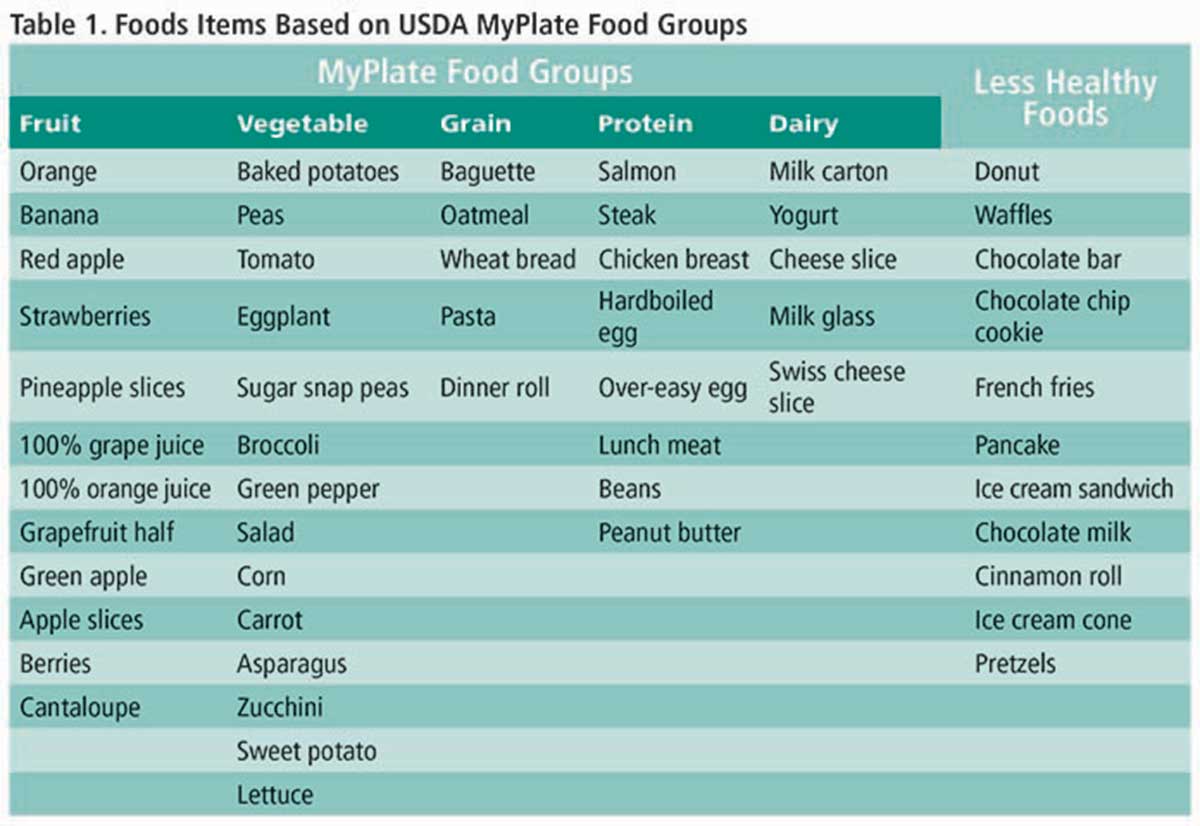
HPPs were assessed using a five-point scoring system. One point was assigned to each of the five USDA food groups, with a maximum total score of five. If a food group was represented more than once, only one point was given. Items from the less healthy food group were given zero points. Classification of healthy and less healthy foods was based on the “We Can: Go, Slow, Whoa” food system, in which “Go” foods are considered healthy and “Whoa” foods are less healthy (National Heart, Lung, & Blood Institute, 2013). Figure 2 shows a pre-test HPP with a total score of 2. Figure 3 is a post-test with a total score of 5.
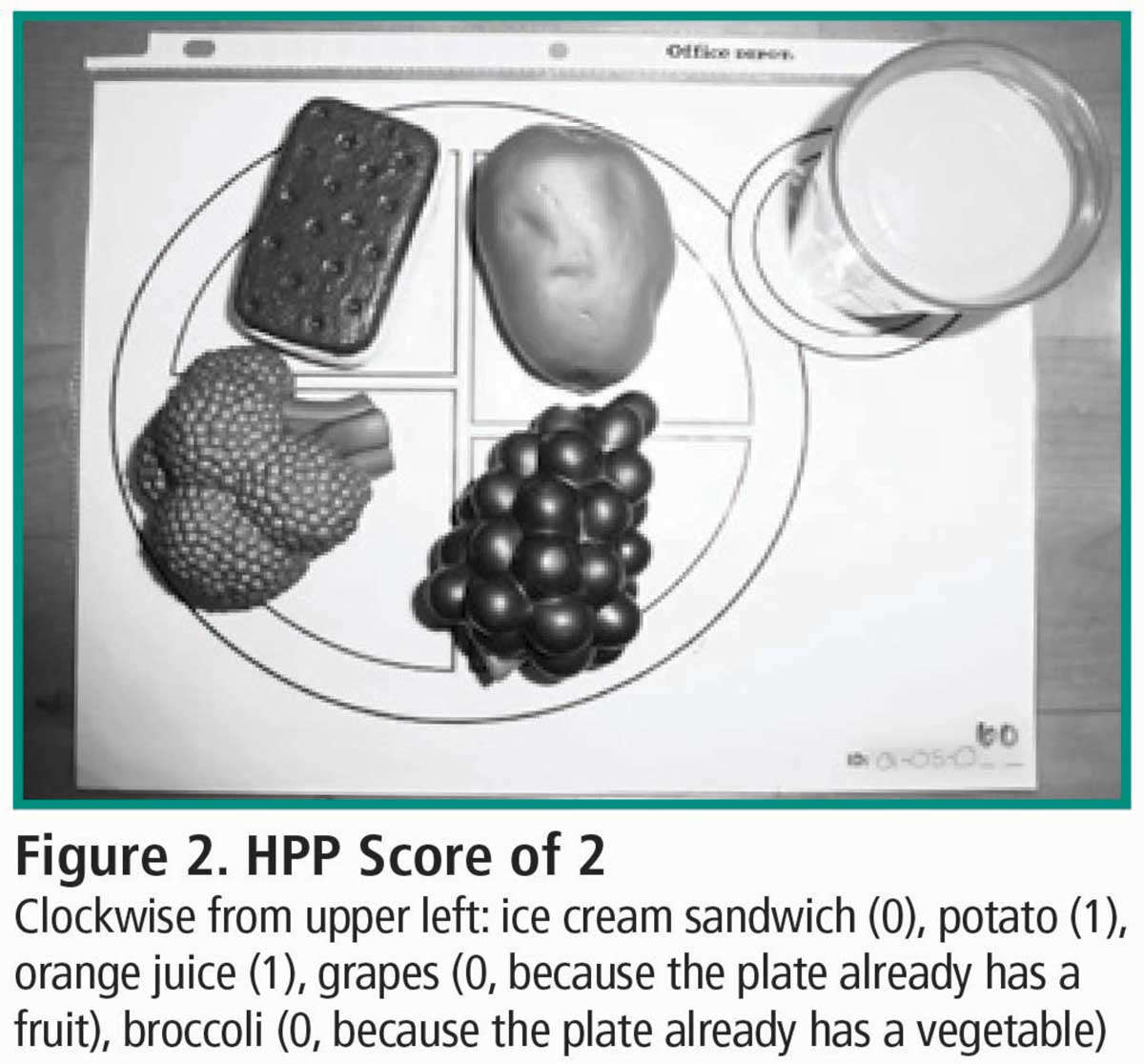
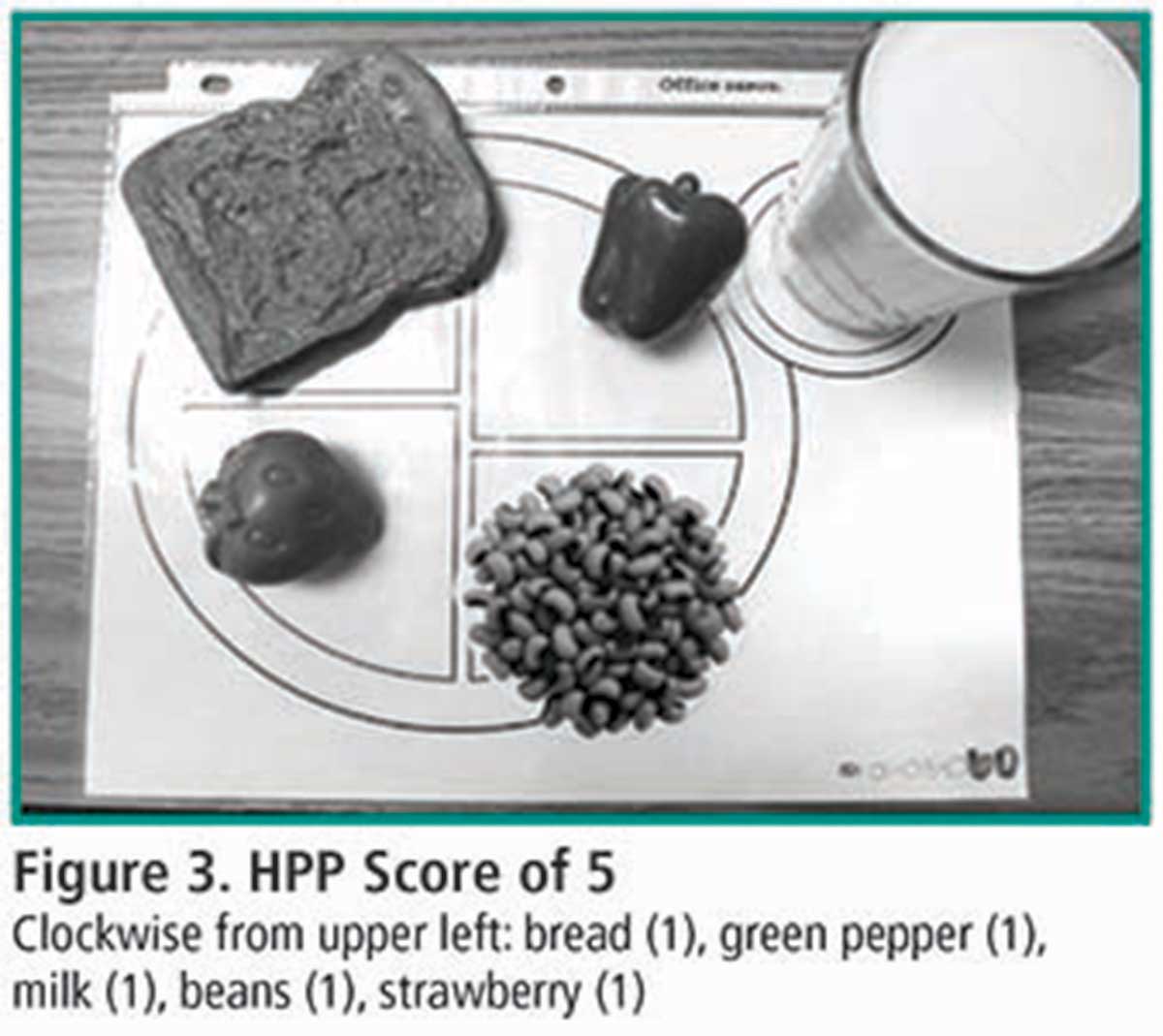
Nutrition Knowledge Paper Survey
Participants’ nutrition knowledge was assessed using three items from the Healthy Habit Survey, a validated paper instrument developed to assess self-reported nutrition knowledge, behavior, and self-efficacy among fifth-grade students (Hall, Chai, Koszewski, & Albrecht, 2015). The three knowledge items we used covered healthy snacks, the benefits of breakfast, and recommended daily servings of fruit and vegetables. Results from these three questions served to confirm the results of the HPP method.
Data Analysis
We used paired t-tests to assess changes in HPP scores and in Healthy Habit Survey nutrition knowledge scores from before the WeCook intervention to after the intervention. Correlations between HPP scores and nutrition knowledge scores were assessed using correlation coefficients.
Results
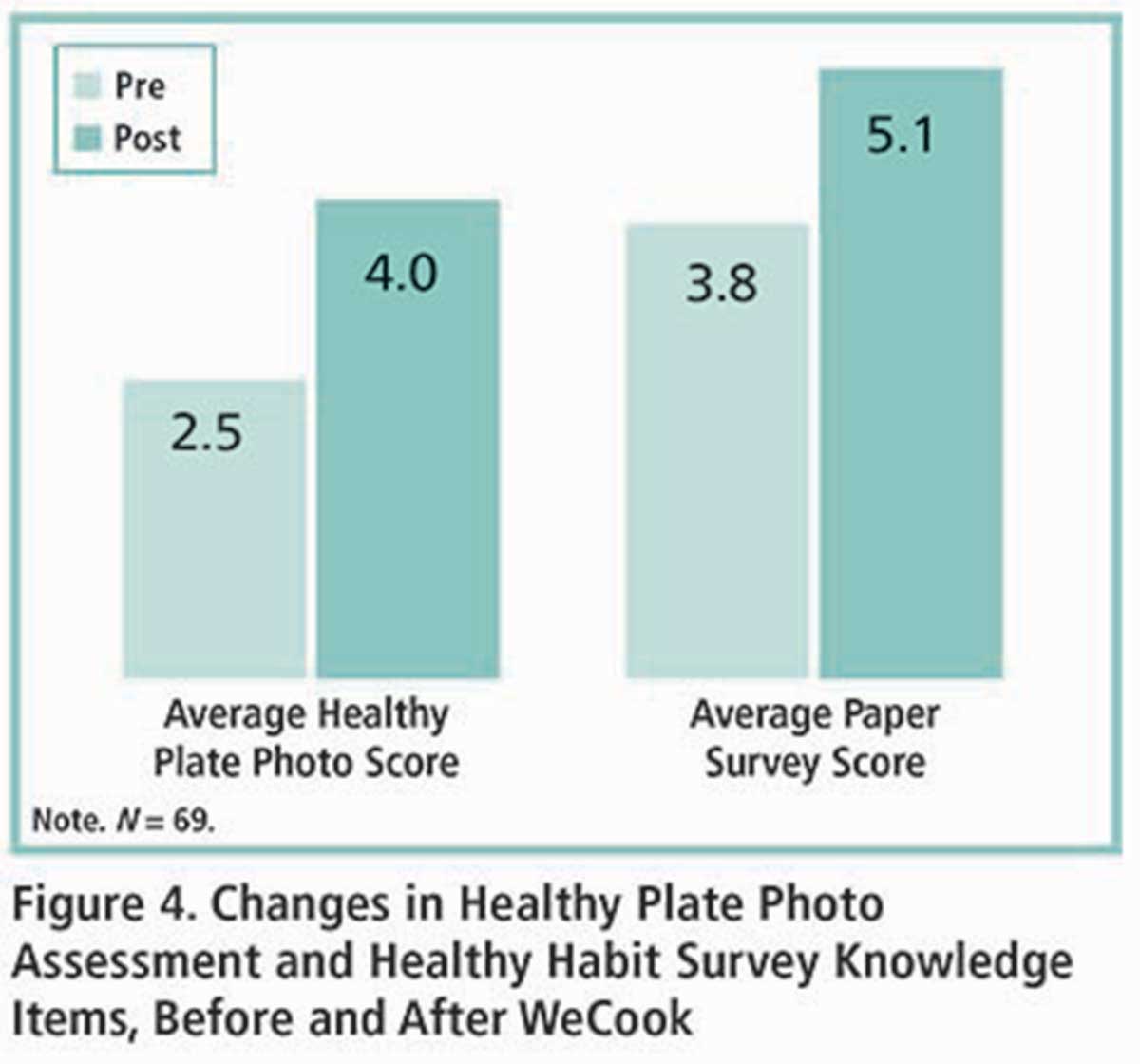 Figure 4 shows the average pre- and post-intervention scores of WeCook participants for both the HPP assessment and the Healthy Habit Survey knowledge items. The HPP scores correlated to participants’ survey scores at a statistically significant rate. The average HPP score achieved by participants significantly increased from 2.5 out of 5 before the WeCook intervention to 4.0 after the intervention. The average nutrition knowledge scores increased significantly from 3.8 at pre-intervention to 5.1 at post-intervention. In addition, statistically significant increases emerged in two of the three Healthy Habit knowledge items, on the benefits of a daily breakfast and on healthy snack choices. Scores also increased on the third item, knowledge of the recommended daily intake of fruit and vegetables, though the difference did not attain statistical significance. Figure 5 shows the breakdowns of participant scores on the HPP assessment pre- and post-intervention, divided into Figure 2. HPP Score of 2 Clockwise from upper left: ice cream sandwich (0), potato (1), orange juice (1), grapes (0, because the plate already has a fruit), broccoli (0, because the plate already has a vegetable) Figure 3. HPP Score of 5 Clockwise from upper left: bread (1), green pepper (1), milk (1), beans (1), strawberry (1) three groups: participants scoring 0 to 3 out of 5, those scoring 4 out of 5, and those scoring 5 out of 5. After engaging in the WeCook curriculum, more than half (55 percent) of participants received the maximum score of 5 points, as compared to only 33 percent before the intervention.
Figure 4 shows the average pre- and post-intervention scores of WeCook participants for both the HPP assessment and the Healthy Habit Survey knowledge items. The HPP scores correlated to participants’ survey scores at a statistically significant rate. The average HPP score achieved by participants significantly increased from 2.5 out of 5 before the WeCook intervention to 4.0 after the intervention. The average nutrition knowledge scores increased significantly from 3.8 at pre-intervention to 5.1 at post-intervention. In addition, statistically significant increases emerged in two of the three Healthy Habit knowledge items, on the benefits of a daily breakfast and on healthy snack choices. Scores also increased on the third item, knowledge of the recommended daily intake of fruit and vegetables, though the difference did not attain statistical significance. Figure 5 shows the breakdowns of participant scores on the HPP assessment pre- and post-intervention, divided into Figure 2. HPP Score of 2 Clockwise from upper left: ice cream sandwich (0), potato (1), orange juice (1), grapes (0, because the plate already has a fruit), broccoli (0, because the plate already has a vegetable) Figure 3. HPP Score of 5 Clockwise from upper left: bread (1), green pepper (1), milk (1), beans (1), strawberry (1) three groups: participants scoring 0 to 3 out of 5, those scoring 4 out of 5, and those scoring 5 out of 5. After engaging in the WeCook curriculum, more than half (55 percent) of participants received the maximum score of 5 points, as compared to only 33 percent before the intervention.
Measuring the Effect of Nutrition Programming
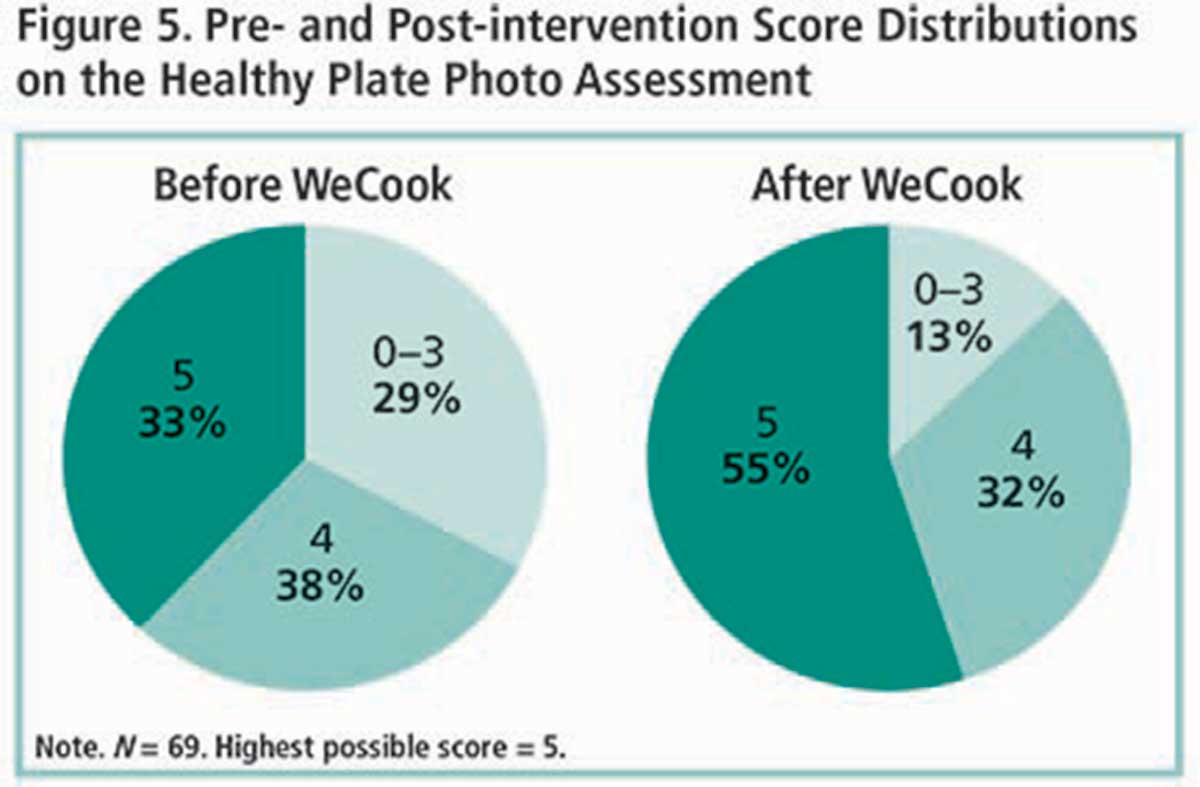 Self-reported paper surveys may not be the best way to measure nutrition knowledge among young people, who may interpret questions incorrectly or may not recall accurate answers (Janz, Lutuchy, Wenthe, & Levy, 2008). The difficulty is exacerbated among underserved youth because they are less likely to be proficient at reading (National Center for Education Statistics, 2016). The HPP method overcomes these difficulties by enabling participants to answer an oral question using tangible objects they can manipulate to build a healthy plate. Young people thus can easily demonstrate their knowledge of USDA MyPlate guidelines without the need to read and answer questions. Although the HPP assessment needs to be further validated in future studies, the current study found a significant positive correlation between HPP scores and nutrition knowledge scores from the validated paper Healthy Habits Survey.
Self-reported paper surveys may not be the best way to measure nutrition knowledge among young people, who may interpret questions incorrectly or may not recall accurate answers (Janz, Lutuchy, Wenthe, & Levy, 2008). The difficulty is exacerbated among underserved youth because they are less likely to be proficient at reading (National Center for Education Statistics, 2016). The HPP method overcomes these difficulties by enabling participants to answer an oral question using tangible objects they can manipulate to build a healthy plate. Young people thus can easily demonstrate their knowledge of USDA MyPlate guidelines without the need to read and answer questions. Although the HPP assessment needs to be further validated in future studies, the current study found a significant positive correlation between HPP scores and nutrition knowledge scores from the validated paper Healthy Habits Survey.
Our study also sought to determine whether participants in WeCook from January 2016 to May 2017 showed significant increases in nutrition knowledge. Both the new HPP method and the conventional paper survey did show such increases. WeCook includes lessons on USDA MyPlate guidelines, recommended fruit and vegetable intakes, the benefits of breakfast, and optimal food and drink choices. After participation, fourth and fifth graders significantly increased their ability to create a healthy plate according to USDA MyPlate guidelines, as shown in their HPP results. They also showed better knowledge of the benefits of breakfast and of healthy snack options, according to the Healthy Habits survey items. These results were consistent with a previous study showing that an experiential food preparation and nutrition education program increased youth nutrition knowledge (Jarpe-Ratner, Folkens, Sharma, Daro, & Edens, 2016).
 Our study suggests that our novel tool for assessing nutrition knowledge among young middle-schoolers is indeed effective. HPP is well suited for the needs of OST programs because it takes little time to administer, is developmentally appropriate, and is easy for both children and adult staff to understand and use. Like the WeCook curriculum itself, the HPP assessment is experiential. The curriculum actively involved young people in learning through hands-on food preparation certainty that gains in nutrition knowledge were due specifically to participation in the WeCook program. More research is needed to confirm our initial promising results. Nevertheless, our study demonstrates that the HPP method can be a practical and useful tool to assess youth nutrition knowledge in OST settings. Afterschool programs that implement healthy lifestyle curricula like WeCook are likely to be interested in such a simple method for measuring changes in children’s nutrition knowledge. Ultimately, the changes we hope to bring about are ones that will help participants make healthy food choices in the future.
Our study suggests that our novel tool for assessing nutrition knowledge among young middle-schoolers is indeed effective. HPP is well suited for the needs of OST programs because it takes little time to administer, is developmentally appropriate, and is easy for both children and adult staff to understand and use. Like the WeCook curriculum itself, the HPP assessment is experiential. The curriculum actively involved young people in learning through hands-on food preparation certainty that gains in nutrition knowledge were due specifically to participation in the WeCook program. More research is needed to confirm our initial promising results. Nevertheless, our study demonstrates that the HPP method can be a practical and useful tool to assess youth nutrition knowledge in OST settings. Afterschool programs that implement healthy lifestyle curricula like WeCook are likely to be interested in such a simple method for measuring changes in children’s nutrition knowledge. Ultimately, the changes we hope to bring about are ones that will help participants make healthy food choices in the future.
Acknowledgment
This project is supported by Children, Youth, and Families at Risk, a funding program through the USDA National Institute of Food and Agriculture to develop and deliver educational programs that equip families and youth with limited resources with the skills they need to lead positive, productive, contributing lives. Grant number 2014-41520-22207.
For references, see PDF
Tags: Engagement, Professional Development, Youth Development, Best Practices, Special Population, Interventions, Outcomes, Healthy Out of School Time
